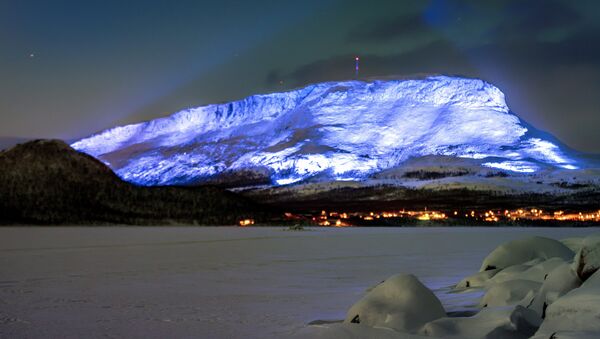The Saana fell in Kilpisjärvi, Finnish Lapland has become the world's largest light installation with an area of 2.5 million square meters of hillside. Standing some 1,000 meters above sea level, it's so enourmous it can also seen from Finland's neighbor countries Sweden and Norway.
"Massive and mystical Saana is a special place for me, as I've walked this fell since my childhood," light artist Kari Kola, a native of northern Finland, explained.
The torching of Saana is part of the Luminous program in which five of the most recognizable domestic landmarks, including the Olavinlinna Castle in Savonlinna and the Näsineula Tower in Tampere are lit up. The series culminates with the lighting up with the Turku Castle in December 6, the Independence Day itself. The artist will have traveled some 3,600 kilometers across Finland by the time the project is finished, in what was described as "extreme places on an extreme timetable."
All the installations utilize a blue-white color scheme mirroring the Finnish flag and are operated by a technical team of 40 people. The project was granted some €295,000 by the Prime Minister's Office, effectively becoming the largest single item of expenditure of the entire celebration.
While gathering immense attention online, the installation also triggered domestic criticism for omitting the indigenous Sami people, who have lived in this region for thousands of years since prehistoric times, as opposed to Finns, whose first settlements in Kilpisjärvi were only built in the early 20th century.
#LuminousFinland100 artwork has lit #Tampere! Näsinneula tower looks mesmerizing 😍#Finland #Suomi100 pic.twitter.com/SqpNK0l6Pf
— Visit Tampere (@VisitTampere) November 30, 2017
Among others, researcher Taarna Valtonen from the Academy of Finland argued that the omission of the Sami people was an affront to the indigenous people's rights tantamount to cultural expropriation, Finnish national broadcaster Yle reported.
Today is Finland's 100 years anniversary of independence. Congrats Finland! #Finland100 #celebration #TurkuCastle #luminousfinland100 pic.twitter.com/mCxGIX6DBT
— Port of Turku (@PortOfTurkuFI) December 6, 2017
Meanwhile, Finns' relentless enthusiasm over the country's centenary has spread across the globe. Tonight, 50 iconic venues and buildings across the globe, including the statue of Christ the Redeemer in Rio de Janeiro, the Niagara Falls in Canada and the Arch of Hadrian in Athens, will be illuminated in blue-white colors in honor of Finland's independence, Yle reported.
Wanna go see the #NiagaraFalls again so cool at night 🤙🏼 pic.twitter.com/BW3d2YnmIg
— [ZS]ProjectZombie (@OfficalProjectZ) December 6, 2017
Finland became independent in 1917, when the Russian Empire began to crumble after the revolutions and the abdication of Tsar Nicholas II. Between 1814 and 1917, it was known as the Grand Duchy of Finland. Before that, Finland has been part of the Swedish realm since the Viking conquest in the Middle Ages.
In Russia, four sights will be illuminated: the Embassy of Finland in Moscow, the Museum of Ethnography in St. Petersburg, the National Theater in Petrozavodsk and the Lumivaara Church in the eponymous village in the Republic of Karelia.
No olihan se nyt aika hieno! #suomi100 #LuminousFinland100 #visittampere pic.twitter.com/dJ7mMqK3kI
— Jenna Jyrkiäinen (@JennaJyrkiainen) December 1, 2017
Lumoava linna itsenäisyyspäivän aattoillassa #Suomi100 #Turunlinna #Turku #luminousFinland100 pic.twitter.com/iCtcYCnhGR
— Satu Meretoja (@SMeretoja) December 5, 2017


